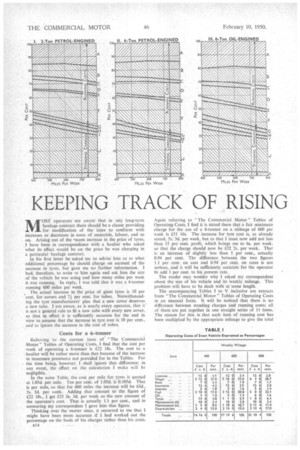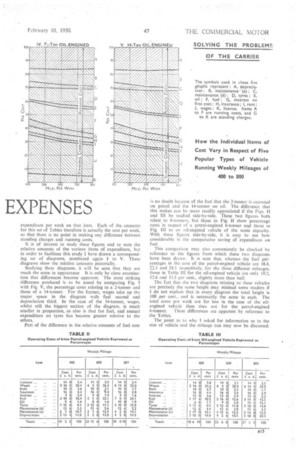KEEPING TRACK OF RISING EXPENSES
Page 48

Page 49

Page 50

If you've noticed an error in this article please click here to report it so we can fix it.
OST operators are aware that in any long-term haulage contract there should be a clause providing for modification of the rates to conform with increases or decreases in costs of materials, labour, and so on. Arising out of the *ecent increase in the price of tyres, .1 have been in correspondence with a haulier who asked what its effect would be on the price he was charging in a particular haulage contract. In his first letter he asked me to advise him as to what additional percentage he should charge on account of the increase in tyres, but gave me no further information. I had, therefore, to write to him again and ask him the size of the vehicle he was using and how many miles per week it was running. In reply, I was told that it was a 6-tonner running 600 miles per week. The actual increase in the price of giant tyres is 10 per cent. for covers and 71 per cent. for tubes. Notwithstanding the tyre manufacturers' plea that a new cover deserves a new tube. I am aware, as is nearly every operator, that it' is not 'a general rule to fit a new tube with every new cover, so that in effect it is sufficiently accurate for the end in view to assume that the increase in tyre cost is 10 per cent., and to ignore the increase in the cost of tubes.
Costs for a 6-tonner Referring to the current issue of "The Commercial Motor" Tables of Operating Costs, I find that the cost per week of operating a 6-tonner is £22 18s. The cost to a -haulier will be rather more than that because of the increase in insurance premiun.s not provided for in the Tables. For the time being, however, I shall ignore that difference; in any event, the effect on the calculation I make will be In the same Table, the cost per mile for tyres is quoted at 1.05d. per mile. Ten per cent. of 1.05d. is 0.105d. That is per mile, so that for 600 miles the increase will be 63d., 5s. 3d. per week. Adding that amount to the figure of £22 18s., I get £23 3s. 3d. per week as the new amount of the operator's cost. That is actually 1.1 per cent., and in answering my correspondent I gave him that figure. Thinking over the matter since, it occurred to me that I might have been more accurate if I had worked out the percentage on the basis of his charges rather than his costs. Again referring to The Commercial Motor" Tables of Operating Costs, I find it is stated there that a fair minimum charge for the use of a 6-tonner on a mileage of 600 per week is £31 16s. The increase for tyre cost is, as already stated, 5s. 3d. per week, but to that I must now add not less than 15 per cent, profit, which brings me to 6s. per week. so that the charge should now be £32 2s. per week. That is an increase of slightly less than 1 per cent., actually 0.94 per cent. The difference between the two figures 1.1 per cent on cost and 0.94 per cent, on rates is not serious, and it will be sufficiently accurate for the operator to add 1 per cent. to his present rate. The reader may wonder why I asked my correspondent about the size of his vehicle and its weekly mileage. This problem will have to be dealt with at some length. The accompanying Tables I to V inclusive are extracts from "The Commercial Motor" Tables of Operating Costs in an unusual form. It will be noticed that there is no difference between standing charges and running costs; all of them are put together in one straight series of 11 items. The reason for this is that each item of running cost has been multiplied by the appropriate mileage to give the total
expenditure per week on that item. Each of the amounts for this set of Tables therefore is actually the cost per week, so that there is no point in making any difference between standing charges and running costs.
It is of interest to study these figures and to note the relative amounts of the various items of expenditure, but in order to facilitate this study I have drawn a corresponding set of diagrams, numbered again I to V. These diagrams show the relative amounts pictorially.
Studying these diagrams, it will be seen that they are much the same in appearance It is only by close examination that differences become apparent. The most striking difference produced is to he noted by comparing Fig. I with Fig. V. the percentage costs relating to a 2-tonner and those of a 14-tonner. For the former, wages take up the major space in the diagram with fuel second and depreciation third. In the case of the 14-tonner, wages, whilst still the biggest section of the diagram, is much smaller in proportion, as also is that for fuel, and annual expenditure on tyres has become greater relative to the others. , Part of the difference in the relative amounts of fuel cost is no doubt because of the fact that the 2-tonner is operated on petrol and the 14-tonner on oil. The difference that this makes can be more readily appreciated if the Figs. II and III be studied side-by-side. These two figures both relate to 6-tonners, but those in Fig. II show percentage costs in respect of a petrol-engined 6-tonner and those in Fig. HI to an oil-engined vehicle of the mine capacity. With these figures side-by-side, it is easy to see how considerable is the comparative saving of expenditure on fuel.
This comparison may also conveniently be checked by reference to the figures from which these two diagrams have been drawn. It is seen that, whereas the fuel perCentages in the case of the petrol-engined vehicle are 18.4, 22.1 and 24.1 respectively, for the three different mileages, those in Table III for the oil-engined vehicle are only 10.2, 12,6 and 13.5 per cent., slightly more than half.
The fact that the two diagrams relating to these vehicles are precisely the same height may mislead some readers if I do not explain that in every diagram the total height is 100 per cent., and is necessarily the same in each. The total costs par week are far less in the case of the oilengined vehicle than they are for the petrol-erigined 6-tonner. These differences nre apparent by reference to the Tables.
The point as to why I asked for information as to the size of vehicle and the mileage run may now be discussed.
Taking first the case of the 6-ton petrol-engined vehicle, I will deal with the question as it came to me. I take first figures from the column headed "600 miles per week." The total cost per week is given as £23 15s. 6d. That this figure differs slightly from the figures given earlier in the article is because of the point which I have already stressed, that in these tabulated figures I have put down the proper amount for insurance premiums which a haulier will have to pay and not those given in "The Commercial Motor" Tables of Operating Costs, which are strictly applicable to vehicles operated by ancillary users. That point is made clear in the introduction to the Tables, so that readers and users of those Tables can make appropriate corrections where necessary.
The 10 per cent. increase in tyre cost is an addition of 10 per cent. to £2 12s. 6d., the amount set down for tyre cost under the heading of 600 miles in Tabl II. A 10 per cent, increase on that would mean adding 5s. 3d., and a corresponding 5s. 3d. to the total cost, which would then become £24 Os. 9d. The percentage increase is thus shown to be 1 I per cent.. as already indicated. At 400 miles per week, the increase is only 10 per cent. on £1 15s., the cost of tyres on that mileage, That is only 3s. 6c1., which increases the weekly cost from £19 2s. 2d. to £19 5s. 8d. That is only 0.9 per cent.
'Higher Tyre Costs
At 800 miles per week, a 10 per cent. increase in tyre cost must be added to £3 lOs , that is 7s., which makes a total cost per week of £29 7s. 10d. instead of £29 Os. 10d. The increase there is practically H per cent. That explains why it is necessary to know the weekly mileage if the inquirer's question is to be answered with any degree of accuracy.
Now let us examine the cost of the 14-tonner. Taking the original figure of 600 miles per week, it is noted that the tyre cost per week there is £5 14s. Ten per cent, of that is practically I Is. 6c1., which would increase the total weekly cost of £35 19s. 6d. to £36 I Is., and that is If per cent., much more in any case than the 6-tonner and actually 40 per cent. more than the incre.ase in overall cost of a 6-tonner running the same weekly mileage, namely, 600. If the 14-tonner runs 800 miles per week, then the tyre cost is £7 12s., and an increase of 10 per cent, on that is I5s. 2d. That addition to the total cost brings it from £42 7s. 10d. to £43 3s., an increase of 11 per cent.
The Tables Brought Up to Date
It is interestirrg to consider now, and in respect of one vehicle only, certain other increases in costs which have taken place since the cutrent._;edition of "The Commercial Motor" Tables cif Operating Costs as published. There has -been an increase in the cost of petrol of approximately 15 per cent., and an increase in maintenance costs of approximately the same amount, in addition to the 10 per cent, increase in tyre costs. Considering these increases in relation to the figures in Table II, which give the cost of operation of a petrol-engined 6-tonner, the fuel cost at 600 miles per week is £5 5s., and 15 per cent. of that is 15s. 9d. The cost of maintenance (e) is £3 Is. 6d., and 15 per cent, of that is 9s. 9d There is also the 5s. 3d. for tyres, so that the total increase is £1 10s. 9d, per week, bringing the total cost from £23 15s. fxl. to 125 6s. 3d., which is an increase on thetotal cost of approximately 6.1 per cent.
If the same size vehicle be running 800 miles per week-, the corresponding figures are £1 Is. per week for petrol, 7s. per week for tyres and 12s. 3d. per week for maintenance, £2 Os. 3d. in all, bringing the total cost to £31 Is. Id. per week instead of £29 Os. 10d., which is an increase of
7 per cent. S.T.R.




















































































